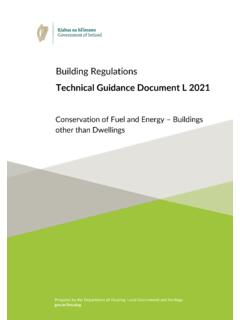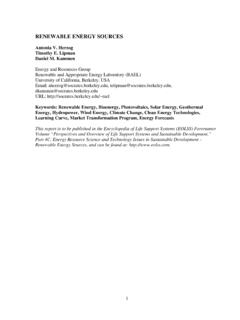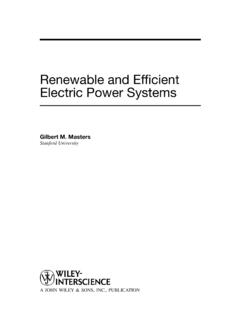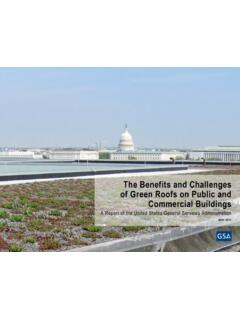Transcription of Overview of the Solar Energy Industry and Supply Chain
1 Overview of the Solar Energy Industry and Supply ChainPrepared for the BlueGreen AllianceBy Stone & AssociatesJanuary, 2011 IntroductionThis Overview of the Solar Energy Industry and Supply Chain was prepared for the BlueGreen Alliance Foundation s Clean Energy Manufacturing Center (CEMC) as the first step in identifying opportunities to increase the base of domestic suppliers in the Solar Energy Industry . The Overview includes general information about the Solar Energy market as well as current installed capacity and expected growth, but its primary focus is the Solar Energy Supply Chain .
2 Building the domestic Supply Chain for the Solar Energy Industry has the potential to create jobs while accelerating the transition to a clean Energy BlueGreen Alliance Foundation (BGAF) is a non-profit, 501 (c) (3) organization. BGAF conducts research and educates the public and media about solutions to environmental challenges that create economic opportunities for the American people. The CEMC seeks to identify job creation opportunities in the wind and Solar Energy sectors and works with manufacturers, public officials, and others to grow the domestic base of suppliers in the clean Energy manufacturing document is based solely on secondary research to develop a set of Industry information that can be used to help manufacturers participate in Solar Industry growth.
3 The document is a starting point to assist in determining where and how to focus resources to maximize employment growth in the Solar Industry . The assessment of job creation opportunities in section one is preliminary, and requires additional primary research to validate and elaborate. 2 Section Assessment of Job Creation Opportunities in Solar Includes PV manufacturing opportunities by Supply Chain Technologies Installed Capacity and GrowthOverview of PV, CSP, and (PV) Global Supply Chain and in PV Production, Supply and DemandNational incentives for production facilities and competitive advantage in a global Solar Power (CSP)Includes list of manufacturers by Supply Chain Heating and cooling (SHC)Includes list of Industry Employment31.
4 Summary Assessment of Job Creation Opportunities in SolarTopics Covered In This Section Summary of Job Creation Opportunities by Solar Segment Assessment of Job Creation Opportunities within PVby Supply Chain ComponentThis section shares a set of preliminary hypotheses, to be confirmed with additional primary of Job Creation Opportunities by Solar SegmentPhotovoltaicSolar ThermalDistributedPhotovoltaicCurrent US Employment (2010): ~55 K ProjectedUS Employment (2016): 197 KLargest employment potentialSolar Heating and CoolingCurrent US Employment (2010): few thousand ProjectedUS Employment (2016): 13K Limited employment potential (unless demand increases)Central / UtilityConcentratedSolar PowerCurrent US Employment (2010): few thousandProjectedUS Employment (2016): 20 KStrong competitive position, but limited employment potentialEmployment Projections depend Heavily on Demand Assumptions/ProjectionsNote: Employment estimates are based on sources cited in employment section.
5 Numbers above include only direct and indirect employment. Projections are probably overstated (Navigant Consulting) because they do not take into account foreign competition for manufacturing value added. 56 Summary of Job Creation Opportunities by Solar Segment (continued)PhotovoltaicSolar ThermalDistributedPV Distributed Low penetration significantopportunity (only 29K residential installations in 2009) Incentives now beginning to spark growth High jobs per MW, driven by substitution of labor and equipment for fuel, and installation work on site Opportunities for job growth.
6 Installation/construction as US demand grows Some in manufacturing, particularly in modules, though low cost countries are increasing share of manufacturing US producers may need to focus on niche technologies, such as thin film where they have been strongSolar Heating and cooling Low penetration significant opportunity 90% of current installed base is poolheating Market recently revived by localand federalincentives Employment numbers, current and projected, are very low Opportunities for job growth: Installation as US demand is spurred by government incentivesCentral / UtilityPV Utility Rapidgrowth High jobs per MW, driven by substitution of labor and equipment for fuel (but lower than distributed) Opportunities for job growth.
7 Installation/construction as US demand grows (but considerably less than distributed) Some in manufacturing, particularly in modules, though low cost countries are increasing share of manufacturing US producers may need to focus on niche technologies, such as thin film where they have been strongCSP 95% of globalcapacity is in the US Growthslowed after installations in 1980s Major resurgence underway: Projects under development represent over 20X current capacity US has unique strength in this technology due to sunlight in Southwest Job potential per MW is considerably lower than PV Assessment of Job Creation Opportunities Within PV By Supply Chain ComponentSupplyChainJobs Per MW (Residential)TrendsOpportunitiesOperatio ns & (FTEs)
8 Small employmentLimited opportunitySystem Integration,Installation, to end-market will grow as demand increases, driven by policyPolicies to stimulate demand should create jobs in this segmentModules & in response to global demand, but increasingly growth captured by low cost countriesUphill battle. US producers may need to focus on niche technologies, such as thin film or ribbon. Module plants are more likely than cell plants to be located near the customer in North AmericaWafersHas been area of US strength, but now shifting to vertically integrated players in low cost countriesDifficult to compete against ChinaOtherComponents (BoS) informationInsufficient Information72.
9 Solar Technologies Installed Capacity & GrowthTopics Covered In This Section Overview of Solar Technologies Installed Capacity by Technology and Application Annual Installations and Growth Cost Comparisons with Other Energy Sources8 Overview The Solar Industry Can Be Segmented By Technology & ApplicationApplicationPhotovoltaic (PV) Generates electricity from the sun through semi-conductors Solar Thermal (ST) Usesthe sun to heat a working fluidDistributed Located at the user Residential, commercial/industrial Can be tied to the grid or not connectedto the gridPV on the roof Photonsin sunlight are absorbed by semiconductors, causing electrons to move.
10 This current is electricity. Electricity is converted from DC to AC and is either used immediately, stored in a battery or sent back to the utility grid SolarHeating & cooling (SHC) These low and medium temperaturecollectors do not generate electricity Heats liquid which is used to heat or cool a home or building ( ; Solar water heaters, Solar pool heaters, and Solar cooling *) Note: often the term Solar thermal only includes these non-electricity generating technologies ( does NOT include CSP)* Solar cooling uses heat to create air-conditioningCentral/UtilityPV-Utilit y Concentrating Solar Power(CSP) Concentrated sunlight heats a fluid which drives a turbine to generate electricity Generates Electricity9 Photovoltaic Utility ScaleSource.






